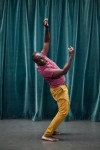Salia Sanou said he is all too familiar with borders generated by colonizers and the impact they’ve had in the region.
His knowledge of such man-made boundaries has guided his work as a dancer from Burkina Faso, using movement to explore the ideas of borders and territory, he said. During periods of colonization, European countries drew their own borders to divide up land, without regard for the existing geographical and cultural divides that existed in such regions. This created problems, like war, that serve as obstacles to living together, and he has translated that understanding into an awareness of borders, Sanou said.
Sanou, the inaugural recipient of the Alma Hawkins Memorial Chair for UCLA’s world arts and cultures/dance department, will present “Dancing Across Borders,” a multimedia event that uses dance to examine themes of borders and the body. Sanou plans to begin the event by playing videos, performing a solo dance and then delivering a short talk. The performance, which will take place Thursday, will give Sanou a chance to share his distinct perspective on the relationship between one’s body and the world, as conveyed through dance, he said.
“I’ve found the body to be a useful means, especially dancers’ bodies as a useful means, for questioning these different territories, looking at them, interrogating them,” Sanou said. “I am a global citizen and that definitely affects my work, and this talk that I’m giving will talk about what I’ve seen, what I’ve lived and today’s world.”
When the world arts and cultures/dance faculty was selecting an artist for the Alma Hawkins Memorial Chair, one of their primary considerations was the artist’s ability to expand students’ understanding of dance cultures in the world, said world arts and cultures/dance chair Dan Froot. The faculty chose Sanou due to his ability to challenge conceptions of African dance as a whole, through specific exposure and thoughtful education. As chair, Sanou will be teaching two classes, and the performance adds another dimension to his impact on students.
“He represents a generation of African artists who are really able to communicate, beyond their audiences in Africa, the way that Africa is changing and has been changing,” Froot said. “In terms of the cultural vibrancy and the engagement in the rest of the world, I think there’s too often an image of African art being sort of frozen in tradition, and it’s just not reality.”
World arts and cultures/dance lecturer Wilfried Souly said he experienced firsthand Sanou’s ability as an instructor to connect traditional Burkinabe dance. Sanou taught at the youth dance company in Burkina Faso where Souly danced as a child. The company focused on teaching the traditional dances of the country, but Sanou, who is also from Burkina Faso, showed Souly a different approach, blending the boundaries between tradition and modernity, Souly said.
“This guy came in and he started teaching us a different way to move our bodies, still using our traditional dances,” Souly said. “I admit that I was a little bit surprised, I was like, ‘What is this, what is that?’ … I found it really interesting and more free for me.”
Part of Sanou’s outlook on using the body within art is conceptualizing the body as a territory that moves within other territories, Sanou said. Sanou describes various territories – physical, mental and geographic – that interact with each other through dance, and using that awareness to center his thoughts and choices while dancing.
“When we come to a physical territory, we come with our own body, which is its own territory, which is our cultural identity, our way of talking, our way of eating, our language,” Sanou said. “(It’s) very interesting for the body of a dancer to explore these dimensions of physical territories that we travel across that influence us as we look at the world and our way of living in the world.”
Sanou’s focus on borders is also specific to his identity. As an African who self-identifies as a global citizen, Sanou said he has observed how borders can be a fraught topic because of the way they impact people who weren’t involved in their creation through violence and conflict.
Sanou will show videos of his previous dances and choreography and then perform a solo dance, before speaking on the topic of borders and territories. The range of mediums used within the performance is meant to help audiences connect with his message, adding a new dimension for audiences to understand and interact with, he said.
“Rather than just standing up there and talking, it’s better to dance and to be in action to give something physical for the public, so they can see my work with another dimension,” Sanou said. “It’s really complementary. … I really like this form of engaging the audience, that I’m always in action.”
The themes of Sanou’s performance relate directly to the lessons he imparts in the classes he teaches as the Alma Hawkins Memorial Chair, he said. Sanou hopes his performance can not only help students and audience members discover a new way of looking at dance, but can also shed specific light on the importance of African dance on the global stage.
“I really want to talk about how Africa has artists that can contribute, that can take their place in relation to the evolution of the arts and can talk about how culture can bring tolerance between people,” Sanou said. “I really want to show that Africa is not a museum. Africa lives, Africa is thirsty to contribute to human development, to … show that there’s contemporary art in Africa, specifically in dance.”
Sanou’s speech was translated from French by Elyan Hill, a graduate student in the department of world arts and cultures/dance.
